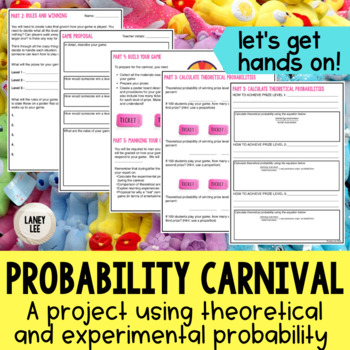Probability Carnival Game Project - PDF & Digital
- PDF
- Google Apps™
- Easel Activity

What educators are saying
Description
Looking for a fun, hands on way to bring probability to life? Are you ready to move past the "sit and get" style of whole group instruction? If you answered yes to either of those questions, then this resource is for you!
Keep your students engaged and accountable with the interactive, versatile Probability Carnival! The steps of this project are designed to be rigorous and require students to predict, reflect, connect, and think critically about the situations being investigated.
Using this project, student will design and run a carnival game with compound events leading up to 3 levels of prizes. Students must submit a game proposal and get approved by their teacher, calculate the theoretical probability of winning each prize, and then collect data and determine experimental probability. Reflection questions are included at the end.
What's Included?
- Teacher Tips
- 10 page Student Packet
- Sample Project
- Rubric
- Student Progress Tracker
Purchase secures a printable PDF file in color. On page 2 of this resource you will find a link to a student friendly Google Slide version of this file. You will be able to copy this file and use it with Google Classroom or any other paperless initiative.
Please take a look at the preview file to see more of this resource.
Who is this resource for?
This resource can be used by classroom teachers, tutors, and parents of students in grades 6-9. It provides a variety of practice covering the mentioned topics.
How Can I Use this Resource?
- Use this resource to practice and reinforce skills in determining theoretical and experimental probability
- The Probability Carnival makes a great summative project or end of the year hands on activity
- Extension activity for early finishers or for students who show a special interest in the topic
This is an Easel Resource Too!
We know you're busy, so this resource has already been prepped for use in Easel by TPT. That means that in the Easel Activity, all non-student pages have been removed and answer boxes have been added where they're needed. You can assign this resource to your students as a fillable PDF just seconds after purchasing, with no extra steps on your end.
More questions?
Email me at laneyleeteaches@gmail.com.
-------------------------------------------------------------------------------------------------------------------------------
*****Check out this blog post to see more examples of student work!******
-------------------------------------------------------------------------------------------------------------------------------
To stay updated on sales and new products, please follow my store:
Connect and chat with me!






